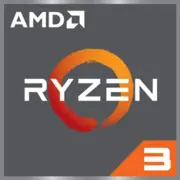AMD Ryzen 3 PRO 4350GE

AMD Ryzen 3 PRO 4350GE: Budget APU for Office and Multimedia
April 2025
Key Features: Zen 2, 7nm, and Integrated Graphics
The AMD Ryzen 3 PRO 4350GE processor, released in 2020, remains relevant in 2025 due to its successful combination of energy efficiency and performance.
Architecture and Manufacturing Process
- Codename: Renoir (Zen 2 architecture).
- Manufacturing Process: TSMC 7nm FinFET — provides low thermal output (TDP 35W) and high efficiency.
- Cores/Threads: 4/8 — multithreading for basic work tasks.
- Cache: L3 — 4MB (sufficient for light applications but limited for heavy workloads).
- Graphics: Radeon Vega 6 (6 compute units, clock speed up to 1700 MHz) — allows for the omission of a discrete graphics card in less demanding scenarios.
Performance:
- Geekbench 6: 1522 (single-core) / 5062 (multi-core).
- Real-World Tests: In 2025, the chip handles office suites (Microsoft Office, Google Workspace), a browser with 10+ tabs, and 4K streaming video.
Key PRO Series Features:
- Security Technologies: AMD Shadow Stack, Secure Processor.
- Improved support for corporate systems (e.g., remote management via DASH).
Compatible Motherboards: AM4 and Chipsets
The Ryzen 3 PRO 4350GE uses the AM4 socket, providing access to a wide range of motherboards.
Recommended Chipsets:
- B550: Optimal choice (PCIe 4.0, NVMe support). Example: ASUS TUF Gaming B550M-Plus ($120).
- A520: Budget option (PCIe 3.0, no overclocking). Example: Gigabyte A520M S2H ($70).
- X570: For enthusiasts, but excessive for this processor.
Important:
- Update the BIOS before installing the processor (some boards require a version from 2020+).
- Avoid outdated chipsets (e.g., A320), where functionality limitations may apply.
Memory: DDR4 and Dual-Channel Mode
The processor supports DDR4 (not DDR5!) with a maximum frequency of 3200 MHz.
Recommendations:
- Configuration: 2×8 GB to activate dual-channel mode (e.g., Kingston Fury DDR4-3200, $45 for the set).
- For office use: 16 GB is sufficient for multitasking.
- For gaming: 32 GB is not necessary but could be useful in the future.
Limitations:
- Unofficial support for modules higher than 3200 MHz — stability is not guaranteed.
Power Supply: Minimum 400W
With a TDP of 35W, the Ryzen 3 PRO 4350GE does not require a powerful PSU, but it's important to account for other components.
Tips:
- Integrated Graphics: A PSU rated at 400–500W (e.g., Corsair CV450, $55).
- If a discrete graphics card is planned: 550–650W (Seasonic Focus GX-550, $90).
- Choose models with an 80 Plus Bronze certification or higher.
Assembly Example:
- Without a discrete graphics card: 450W.
- With a GPU like the NVIDIA GTX 1650: 500W.
Pros and Cons: Who is it Relevant for in 2025?
Advantages:
- Low power consumption: Ideal for compact PCs and mini-PCs (e.g., ASUS PN50).
- Presence of Vega 6: Can run CS:GO (1080p, low settings, 60–70 FPS) or process photos in Lightroom.
- Price: New units in 2025 cost around $90–110.
Disadvantages:
- 4 cores: Lags behind modern 6-core CPUs in multitasking (e.g., rendering in Blender).
- No PCIe 4.0: Limitation for high-speed NVMe drives.
Usage Scenarios: From Office to HTPC
1. Office Tasks:
- Document work, video conferencing, cloud services.
- Example: A PC based on Ryzen 3 PRO 4350GE + 16 GB DDR4 + 512 GB SSD.
2. Multimedia:
- 4K streaming content (Netflix, YouTube) via HDMI 2.0.
- Connect to TV as an HTPC (e.g., via mini-PC Beelink SER4).
3. Light Gaming:
- 2025 games on low settings: Dota 2 (1080p, 80 FPS), Minecraft (100+ FPS).
Comparison with Competitors
1. Intel Core i3-12100 (Alder Lake):
- Pros: Higher single-core performance (Geekbench 6 ~1700), PCIe 5.0.
- Cons: UHD 730 graphics are weaker than Vega 6, price $130.
2. AMD Ryzen 5 4600G (Zen 2):
- Pros: 6 cores/12 threads, Vega 7.
- Cons: TDP 65W, more expensive ($140).
Conclusion: The Ryzen 3 PRO 4350GE excels in the budget segment with a focus on energy efficiency.
Assembly Tips
1. Case:
- Mini-ITX (Cooler Master NR200) for compactness.
2. Cooling:
- The stock cooler is adequate, but for quieter operation, choose the Arctic Freezer 34 ($30).
3. Storage:
- NVMe SSD (e.g., Kingston NV2 1TB, $60) for fast OS loading.
4. BIOS Update:
- Use a USB flash drive with the manufacturer's file for the motherboard.
Conclusion: Who is the Ryzen 3 PRO 4350GE Suitable For?
This processor is an excellent choice for:
- Office PCs: Low power consumption + data protection.
- Home Media Centers: 4K HDR and quiet operation.
- Budget Builds: Costing under $200 for a system without a graphics card.
Do not choose if you need:
- Streaming or rendering — here, the Ryzen 5 5600G is a better option.
- AAA-level gaming in 2025 — a discrete graphics card will be required.
In 2025, the Ryzen 3 PRO 4350GE remains a niche, yet practical solution for those who value a balance between price and functionality.
Basic
CPU Specifications
Memory Specifications
GPU Specifications
Miscellaneous
Benchmarks
Compared to Other CPU
Share in social media
Or Link To Us
<a href="https://cputronic.com/en/cpu/amd-ryzen-3-pro-4350ge" target="_blank">AMD Ryzen 3 PRO 4350GE</a>